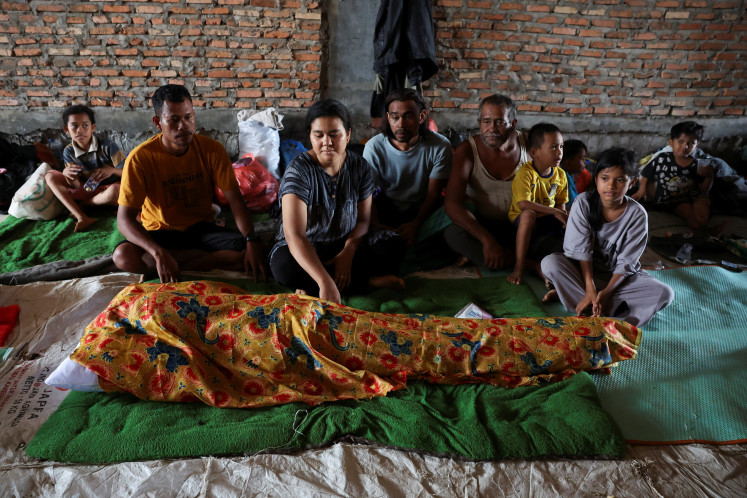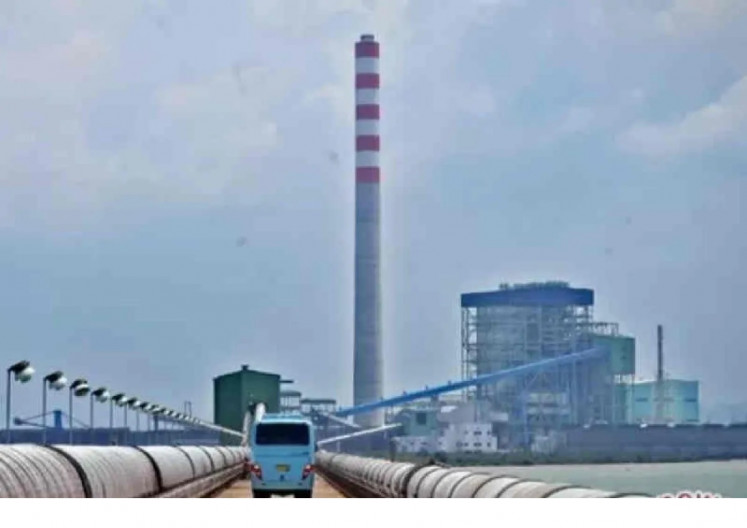Popular Reads
Top Results
Can't find what you're looking for?
View all search resultsPopular Reads
Top Results
Can't find what you're looking for?
View all search resultsRisk of gas shortage haunts Indonesia
“Our supply is very limited and it is expected to continue dropping to around 6,000 mmscfd in 2030. This means that there will be a shortage of 4,000 mmscfd, or 32 tons of LNG,” Pertamina senior vice president for gas and power Djohardi Angga Kusumah said on Tuesday.
Change text size
Gift Premium Articles
to Anyone
 Gas issue: An operator monitors the loading process of LNG tankers into the MT Aquarius tanker berthing at the Donggi Senoro refinery in Uno village, Batu Banggai, Central Sulawesi, in a recent photo. The facility is set to strengthen gas supply to power plants in the western part of Java. (JP/Ricky Yudhistira)
Gas issue: An operator monitors the loading process of LNG tankers into the MT Aquarius tanker berthing at the Donggi Senoro refinery in Uno village, Batu Banggai, Central Sulawesi, in a recent photo. The facility is set to strengthen gas supply to power plants in the western part of Java. (JP/Ricky Yudhistira)
T
he risk of a gas shortage is haunting Indonesia as demand continues to soar on the back of lower supply and poor infrastructure, with 2019 predicted to be the starting point of potential shortages.
State-owned oil and gas giant Pertamina estimates that demand for gas in the form of liquefied natural gas (LNG) will increase by 4 percent to 5 percent every year, mostly boosted by the power and industrial sectors.
Pertamina senior vice president for gas and power Djohardi Angga Kusumah said that in line with the drastic increase in demand, domestic supply would continue to drop due to aging fields and a lack of new discoveries.
As a result, the country could begin seeing a gas shortage of 500 million standard cubic feet per day (mmscfd) in 2019. The demand will continue to climb until 2030, when it is likely to reach around 10,000 mmscfd.
“Our supply is very limited and it is expected to continue dropping to around 6,000 mmscfd in 2030. This means that there will be a shortage of 4,000 mmscfd, or 32 tons of LNG,” he said on Tuesday.
By 2030, most of the shortage will be centered in West Java, with more than 60 percent.
A gas shortage poses a problem since the government has continued to emphasize the need to develop downstream sectors, including the local manufacturing industry and the power sector, to boost productivity and create added value to exports.
However, at around US$9 per million British thermal units (mmbtu), Indonesia’s gas price is considered much higher than of its regional peers. Gas in Malaysia and Singapore hovers at around $4 per mmbtu.
(Read also: Indonesian gas prices still competitive: Deputy minister)
Pertamina estimates that around $70 billion to $80 billion in funds is needed to develop gas infrastructure until 2030.
Djohardi said it had come to the conclusion that with poor infrastructure suspending gas prices at such a high rate, importing LNG was the answer.
Pertamina acting president director Yenni Andayani said Indonesia needed to secure long-term LNG contracts before it was too late as global LNG demand was expected to increase significantly over the next decade.
“It may be too late for us if we wait until 2020 to start talking to suppliers,” she said.
Competition to secure contracts will be fierce among neighboring countries as Southeast Asia’s import demand is forecast to reach around 60 billion cubic meters (bcm) of gas in 2030 from zero in 2013.
The government has begun importing LNG for the electricity sector and is considering doing the same for other industrial sectors.
A recent ministerial decree issued by the Energy and Mineral Resources Ministry allows power producers to import LNG if the price of gas distributed by local pipes is over 11.5 percent of the Indonesian Crude Price (ICP).
(Read also: Residents can now enjoy cheap gas from nearby refineries)
Energy and Mineral Resources Ministry deputy minister Arcandra Tahar said that it was unlikely that it would allow LNG imports this year for the industrial sectors due to a lack of supporting infrastructure and its priority toward domestic supply.
Data from the Upstream Oil and Gas Regulatory Special Task Force (SKKMigas) shows that only 39 of 64 LNG cargoes allocated for the domestic market were absorbed in 2015.
Furthermore, official data shows that there are 63 uncommitted LNG cargoes this year and 60 next year, meaning that they don’t have certain buyers yet.
“We are prioritizing domestic [supply] first. If it does not fulfill demand, we will consider allowing imports. We need to construct the infrastructure first and this may take years,” he said.
At present, there are only two floating storage facilities in West Java and Lampung and only one land-based re-gasification terminal, which is the converted Arun LNG plant in Aceh.
The ministry is planning to construct 11 floating storage facilities and 66 land-based facilities by 2025.
Oil and gas consultancy group FGE president Jeff Brown said Pertamina’s reputation as a seasoned player in the LNG sector should help the country secure contracts.
“Indonesia has a very strong brand identity. I emphasize this because there are new buyers coming in and they will say some crazy things. Sellers like the fact that Pertamina is already in the market and is an established player,” he said.









